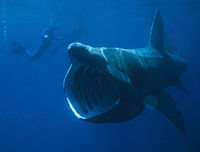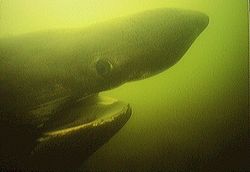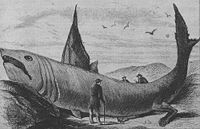Basking shark
| Basking shark Fossil range: 34–0 Ma Early Oligocene to Present[1] |
||||||||||||||||
|---|---|---|---|---|---|---|---|---|---|---|---|---|---|---|---|---|
 |
||||||||||||||||
| Conservation status | ||||||||||||||||
| Scientific classification | ||||||||||||||||
|
||||||||||||||||
| Binomial name | ||||||||||||||||
| Cetorhinus maximus (Gunnerus, 1765) |
||||||||||||||||
 Range (in blue)
|
The basking shark, Cetorhinus maximus, is the second largest fish, after the whale shark. It is a cosmopolitan species — it is found in all the world's temperate oceans. It is a slow moving and generally harmless filter feeder.
Like other large sharks, basking sharks are at risk of extinction due to a combination of low resilience and overfishing to supply the worldwide market for the shark's fins, flesh and organs.
Contents |
Taxonomy
This shark is called the basking shark because it is most often observed when feeding at the surface and appears to be basking. It is the only member of the family Cetorhinidae. It was first described and named Cetorhinus maximus by Gunnerus in 1765 from a specimen found in Norway. The genus name Cetorhinus comes from the Greek, ketos which means marine monster or whale and rhinos meaning nose, the species name maximus is from Latin and means "greatest". It was later described as Squalus isodus by Macri in 1819, Squalus elephas by Lesueur in 1822, Squalus rashleighanus by Couch in 1838, Squalus cetaceus by Gronow in 1854, Cetorhinus blainvillei by Capello in 1869, Selachus pennantii by Cornish in 1885, Cetorhinus maximus infanuncula by Deinse & Adriani 1953, and finally as Cetorhinus maximus normani by Siccardi 1961.[3]
Distribution and habitat
The basking shark is a coastal-pelagic shark found worldwide in boreal to warm-temperate waters around the continental shelves. It prefers waters between 8 and 14° C (46 and 57° F). It is often seen close to land and will enter enclosed bays. The shark will follow concentrations of plankton in the water column and is therefore often visible on the surface. They are a highly migratory species leading to seasonal appearances in certain areas of the range.[4]
Anatomy and appearance
The basking shark is one of the largest known sharks, second only to the whale shark. The largest specimen accurately measured was trapped in a herring net in the Bay of Fundy, Canada in 1851. Its total length was 12.27 metres (40.3 ft), and it weighed an estimated 19 tons. There are reports from Norway of three basking sharks over 12 m (the largest being 13.7 m), but those are considered dubious since few if any sharks anywhere near such size have been caught in the area since. Normally the basking shark reaches a length of between 6 metres (20 ft) and a little over 8 metres (26 ft). Some specimens surpass 9 or even 10 metres (33 ft), but after years of hard fishing, specimens of this size have become exceedingly rare.

These sharks possess the typical lamniform body plan and have been mistaken for great white sharks. The two species can be easily distinguished, however, by the basking shark's cavernous jaw (up to 1 m in width, held wide open whilst feeding), longer and more obvious gill slits (which nearly encircle the head and are accompanied by well-developed gill rakers), smaller eyes, and smaller average girth. Great white sharks possess large, dagger-like teeth, whilst those of the basking shark are much smaller (5–6 mm) and hooked; only the first 3 or 4 rows of the upper jaw and 6 or 7 rows of the lower jaw are functional. There are also several behavioural differences between the two (see Behaviour).
Other distinctive characteristics of the basking shark include a strongly keeled caudal peduncle, highly textured skin covered in placoid scales and a layer of mucus, a pointed snout (which is distinctly hooked in younger specimens), and a lunate caudal fin. In large individuals the dorsal fin may flop over when above the surface. Colouration is highly variable (and likely dependent on observation conditions and the condition of the animal itself): commonly, the colouring is dark brown to black or blue dorsally fading to a dull white ventrally. The sharks are often noticeably scarred, possibly through encounters with lampreys or cookiecutter sharks. The basking shark's liver, which may account for 25% of its body weight, runs the entire length of the abdominal cavity and is thought to play a role in buoyancy regulation and long-term energy storage.
In females, only the right ovary appears to be functional: if so, this is a unique characteristic among sharks.
Diet
The basking shark is a passive filter feeder, filtering zooplankton, small fish and invertebrates from up to 2,000 tons of water per hour.[3] Unlike the megamouth shark and whale shark, the basking shark does not appear to actively seek its quarry, but it does possess large olfactory bulbs that may guide it in the right direction. Unlike the other large filter feeders, it relies only on the water that is pushed through the gills by swimming; the megamouth shark and whale shark can suck or pump water through their gills.[3]
Behaviour

Studies in 2003 have disproved the idea that basking sharks hibernate and have shown that they are active throughout the year.[5] In winter, basking sharks move to deeper water (depths of up to 900 m) feeding on deep water plankton. Satellite tagging confirmed that basking sharks move thousands of kilometres during the winter months locating plankton blooms. It was also found that basking sharks shed and renew their gillrakers in an ongoing process, rather than over one short period.
They feed at or close to the surface with their mouths wide open and gill rakers erect. They are slow-moving sharks (feeding at about 2 knots) and do not attempt to evade approaching boats (unlike great white sharks). They are harmless to humans if left alone and will not be attracted to chum.
Basking sharks are social animals and form schools segregated by sex, usually in small numbers (3 or 4) but reportedly up to 100 individuals.[4] Their social behaviour is thought to follow visual cues, as although the basking shark's eyes are small, they are fully developed and have been known to visually inspect boats, possibly mistaking them for conspecifics.[6] Females are thought to seek out shallow water to give birth.
These sharks have few predators, but orcas and tiger sharks are known to feed on them, and the aforementioned lampreys are often seen attached to them, although it is unlikely that they are able to cut through the shark's thick skin.[4]
Even though the basking shark is large and slow it can breach and has been reported jumping fully out of the water.[7] This behaviour could be an attempt to dislodge parasites or commensals.[4]
Reproduction
Basking sharks are ovoviviparous: the developing embryos first rely on a yolk sac, and as there is no placental connection, they later feed on unfertilized ova produced by the mother (a behaviour known as oophagy). Gestation is thought to span over a year (but perhaps 2 or 3 years), with a small though unknown number of young born fully developed at 1.5–2 m (5–6.5 ft). Only one pregnant female is known to have been caught; she was carrying 6 unborn young.[8] Mating is thought to occur in early summer and birthing in late summer, following the female's movement into shallow coastal waters.
The onset of maturity in basking sharks is not known but is thought to be between the age of 6 and 13 and at a length of between 4.6 and 6 m. Breeding frequency is also unknown, but is thought to be 2 to 4 years.
The seemingly useless teeth of basking sharks may play a role before birth since the basking shark seems to feed on unfertilized eggs in utero.[9]
Importance to humans

Historically, the basking shark has been a staple of fisheries because of its slow swimming speed, unaggressive nature and previously abundant numbers. Commercially it was put to many uses: the flesh for food and fishmeal, the hide for leather, and its large liver (which has a high squalene content) for oil.[4] It is currently fished mainly for its fins (for shark fin soup). Parts (such as cartilage) are also used in traditional Chinese medicine and as an aphrodisiac in Japan, further adding to demand.
As a result of rapidly declining numbers, the basking shark has been protected and trade in its products restricted in many countries. It is fully protected in the UK, Malta, Florida and US Gulf and Atlantic waters. Targeted fishing for basking sharks is illegal in New Zealand.[8] Once considered a nuisance along the Canadian Pacific coast, basking sharks were the target of a government eradication program there from 1945 to 1970. As of 2008, efforts are underway to determine if any sharks still live in the area and monitor their potential recovery.[10]
It is tolerant of boats and divers approaching it and may even circle divers, making it an important draw for dive tourism in areas where it is common.
Basking sharks and cryptozoology
On several occasions, "globster" corpses initially thought to be sea serpents or plesiosaurs have later been identified as likely to be the decomposing carcasses of basking sharks, as in the Stronsay beast and the Zuiyo Maru cases.
See also
- List of sharks
- List of fish common names
- List of fish families
References
- ↑ Sepkoski, Jack (2002). "A compendium of fossil marine animal genera (Chondrichthyes entry)". Bulletins of American Paleontology 364: p.560. http://strata.ummp.lsa.umich.edu/jack/showgenera.php?taxon=575&rank=class. Retrieved on 2008-01-09.
- ↑ Fowler (2000). Cetorhinus maximus. 2006 IUCN Red List of Threatened Species. IUCN 2006. Retrieved on 11 May 2006. Database entry includes justification for this species' status
- ↑ 3.0 3.1 3.2 C. Knickle, L. Billingsley & K. DiVittorio. "Biological Profiles basking shark". Florida Museum of Natural History. Retrieved on 2006-08-24.
- ↑ 4.0 4.1 4.2 4.3 4.4 Leonard J. V. Compagno (1984). Sharks of the World: An annotated and illustrated catalogue of shark species known to date. Food and Agriculture Organization of the United Nations.
- ↑ Basking Shark
- ↑ Martin, R. Aidan. "A Curious Basker". SHARK-L. Retrieved on 2006-08-03.
- ↑ Pelagic Shark Research Foundation. "PSRF Shark Image Library". PSRF. Retrieved on 2006-06-01.
- ↑ 8.0 8.1 The Shark Trust. "Basking Shark Factsheet". The Shark Trust. Retrieved on 2006-07-07.
- ↑ "Martin, R. Aidan". ""Biology of the Basking Shark(Cetorhinus maximus)"". Retrieved on 2008-06-08.
- ↑ http://www.canada.com/victoriatimescolonist/news/story.html?id=700f1600-1e32-42c5-a54d-4f4cff249c53&k=6955
- General references
- "Cetorhinus maximus". FishBase. Ed. Ranier Froese and Daniel Pauly. 10 2005 version. N.p.: FishBase, 2005.
- Cetorhinus maximus (TSN 159907). Integrated Taxonomic Information System. Retrieved on 23 January 2006.
- David A Ebert, Sharks, Rays and Chimaeras of California, ISBN 0-520-23484-7
- Basking shark, Cetorhinus maximus MarineBio"
- Marine Conservation Society Basking shark page
- FAO Figis Species Fact Sheet for basking shark
External links
- Basking shark, Cetorhinus maximus MarineBio"
- ARKive entry on the Basking Shark
- Basking Shark Profile and Photos
- 9 m Basking Shark captured in Japan
- Basking Shark Project
- The basking shark web page
- Fisheries & Oceans Canada - Basking sharks on the west coast of Canada
- Basking Sharks in the Isle of Man